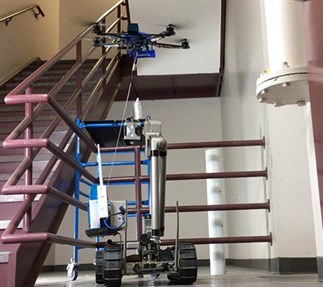Dr. Robin Murphy, Raytheon Professor in the Department of Computer Science and Engineering at Texas A&M University and director of the Texas A&M Engineering Experiment Station’s Center for Robot-Assisted Search and Rescue, saw a need for a safer, more efficient way to use quadcopter unmanned aerial vehicles (UAV) in indoor disaster environments.
Her idea for a quadcopter tethered to a home-base robot was inspired by marsupials, who have external pouches to hold their young and keep them close. Murphy has been working with marsupial robots since 1998, with ground-ground teams and boat-aerial robot teams supported by the National Science Foundation and the Office of Naval Research.
 In the case of her new robots, the ‘mother’ provides a steady connection for the ‘baby’ quadcopter to safely assess the situation of a dangerous, indoor environment without the hazard of crashing into a potentially disastrous object. Not only does the mother provide stability, it delivers a steady power source for the baby to feed off of to stay in-flight longer. Fotokite is the company who developed the quadcopter robot, and Endeavor Robotics developed the PackBot-base mother robot.
In the case of her new robots, the ‘mother’ provides a steady connection for the ‘baby’ quadcopter to safely assess the situation of a dangerous, indoor environment without the hazard of crashing into a potentially disastrous object. Not only does the mother provide stability, it delivers a steady power source for the baby to feed off of to stay in-flight longer. Fotokite is the company who developed the quadcopter robot, and Endeavor Robotics developed the PackBot-base mother robot.
The mother-daughter combination can be used in countless dangerous situations, such as nuclear power or chemical plants where it is unsafe to fly UAVs. It could be used to rapidly respond to an incident or, if used routinely, to prevent damage from occurring.
“We are very excited at how the Department of Energy and the nuclear industry have reacted to this marsupial combination,” Murphy said. “They already use ground robots for inspection but can’t see above six feet. The Fotokite lets them have a virtual mast, but also to see what the ground robot is doing and to help coach it through tight spaces.”
The project, which is funded by the National Science Foundation and the Department of Energy, was recently featured on wired.com.